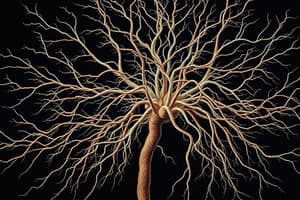Podcast
Questions and Answers
What is the structural and functional difference between the central nervous system and peripheral nervous system?
What is the structural and functional difference between the central nervous system and peripheral nervous system?
- Both A and B are correct. (correct)
- The CNS is the control center, brain and spinal cord.
- The CNS is located outside of the body.
- The PNS consists of nerve fibers that carry information to and from the CNS.
What is white matter composed of?
What is white matter composed of?
Myelinated fibers
Name the types of nerves in the peripheral nervous system.
Name the types of nerves in the peripheral nervous system.
Motor nerves, sensory nerves, mixed
What is the cerebrum?
What is the cerebrum?
What are the functions of the cerebrum?
What are the functions of the cerebrum?
What are the three types of functioning areas in the cerebral cortex?
What are the three types of functioning areas in the cerebral cortex?
What are the functions of the cerebellum?
What are the functions of the cerebellum?
What are the functions of the hypothalamus?
What are the functions of the hypothalamus?
What are the functions of the medulla oblongata?
What are the functions of the medulla oblongata?
What is the function of the corpus callosum?
What is the function of the corpus callosum?
What are the functions of the meninges?
What are the functions of the meninges?
What is the function of the cerebrospinal fluid?
What is the function of the cerebrospinal fluid?
Describe the structure of the spinal cord.
Describe the structure of the spinal cord.
What are the functions of the spinal cord?
What are the functions of the spinal cord?
What are the structures that protect the central nervous system?
What are the structures that protect the central nervous system?
What components work together in a simple spinal reflex arc?
What components work together in a simple spinal reflex arc?
Is the brain involved in spinal reflexes?
Is the brain involved in spinal reflexes?
Why can't the brain be involved in a simple spinal reflex arc?
Why can't the brain be involved in a simple spinal reflex arc?
What is the function of the sensory (afferent) division?
What is the function of the sensory (afferent) division?
Flashcards are hidden until you start studying
Study Notes
Central and Peripheral Nervous System
- The Central Nervous System (CNS) comprises the brain and spinal cord, serving as the control center, while the Peripheral Nervous System (PNS) consists of nerve fibers transporting information to and from the CNS.
- White matter consists of myelinated fibers, located inside the brain and outside the spinal cord, facilitating communication within the nervous system.
- The PNS contains three types of nerves: motor nerves (carry signals to muscles), sensory nerves (carry signals from sensory receptors), and mixed nerves (contain both types).
Cerebrum
- The cerebrum is the largest brain part, characterized by its folds and comprises both grey and white matter.
- Functions include critical cognitive processes such as thinking, reasoning, learning, memory, and the initiation of voluntary muscle control, as well as perceiving sensory input.
Cerebral Cortex Areas
- Sensory areas interpret impulses from receptors, motor areas control muscular movements, and association areas engage in intellectual and emotional processes.
Cerebellum
- The cerebellum is responsible for maintaining posture, balance, and fine motor coordination, but does not initiate movement, ensuring fluid and controlled actions.
Hypothalamus
- The hypothalamus plays a crucial role in homeostasis, regulating the autonomic nervous system, body temperature, food and water intake, sleep patterns, emotional responses, and endocrine functions including metabolism and growth.
Medulla Oblongata
- The medulla oblongata adjusts body systems automatically through specialized centers, controlling heart rate, breathing rate, blood vessel diameter, and reflex actions like swallowing and coughing.
Corpus Callosum
- The corpus callosum facilitates communication between the right and left cerebral hemispheres, ensuring coordinated functioning.
Meninges
- Meninges consist of three connective tissue layers that protect the CNS, covering both the brain and spinal cord.
Cerebrospinal Fluid (CSF)
- CSF provides support, protection, and transport for nutrients and waste within the CNS.
Spinal Cord Structure and Function
- The spinal cord is cylindrical, with white matter on the outside and grey matter on the inside, containing a central canal filled with CSF. It connects muscles and glands to the brain and integrates reflex actions.
Protection of the CNS
- The central nervous system is protected by bones (skull and vertebrae), meninges, and cerebrospinal fluid.
Spinal Reflex Arc Components
- A simple spinal reflex arc includes receptors that initiate nerve impulses in sensory neurons, synapses that transmit impulses to motor neurons, and effectors (muscle or secretory cells) that respond to the commands.
Brain and Reflexes
- While the brain is not involved in the reflex action itself, sensory impulses are sent to the brain afterward, making individuals aware of the situation post-response.
Importance of Reflex Speed
- Reflex arcs operate quickly as protective mechanisms to minimize bodily harm, bypassing slower brain processing for immediate reaction to potential dangers.
Studying That Suits You
Use AI to generate personalized quizzes and flashcards to suit your learning preferences.



